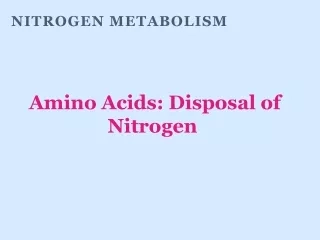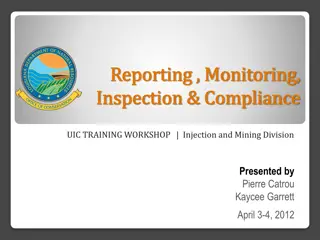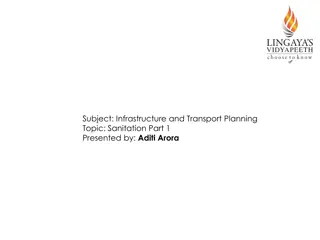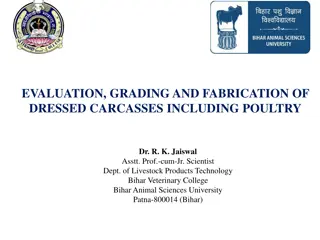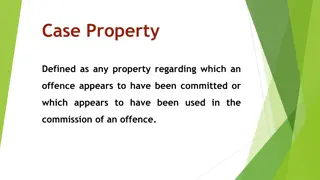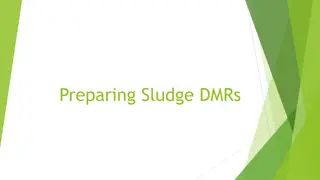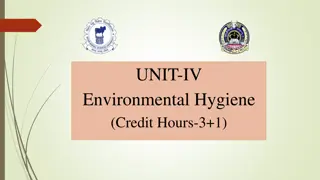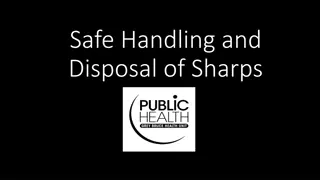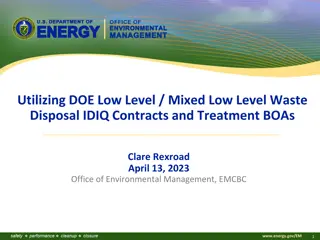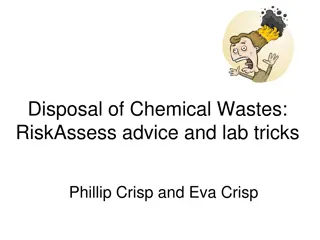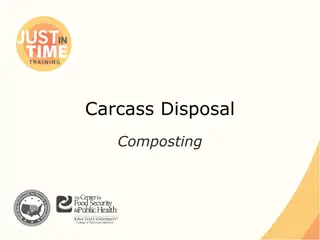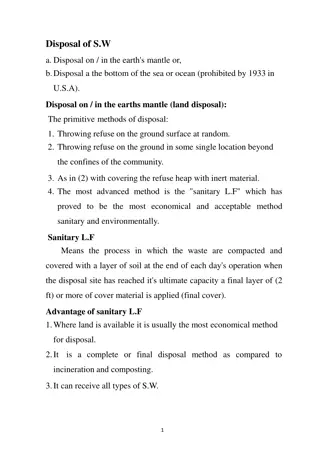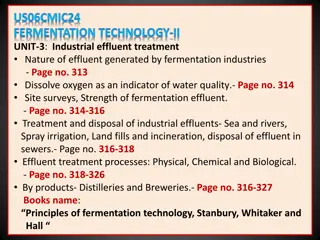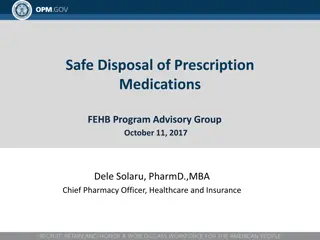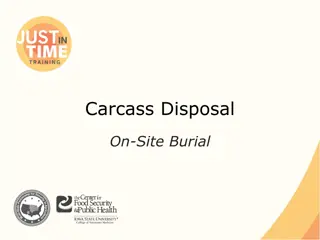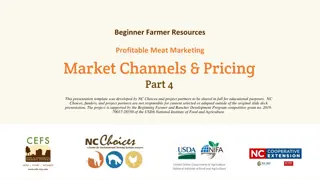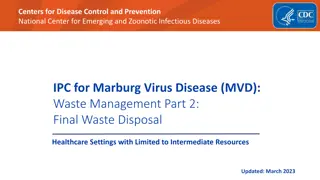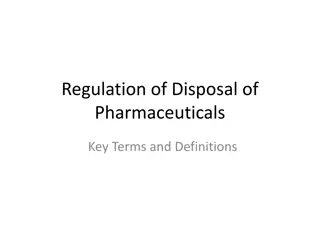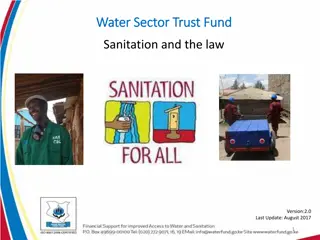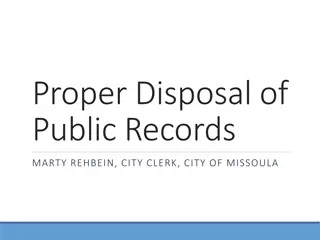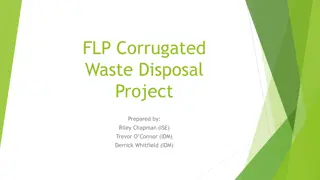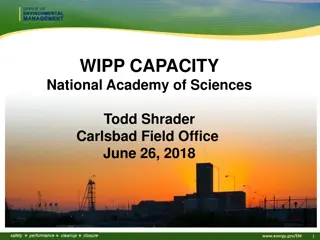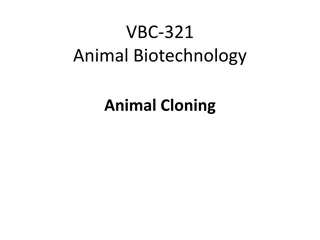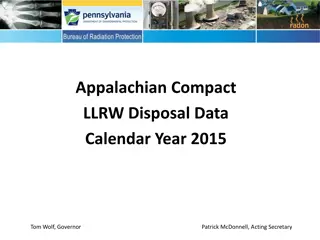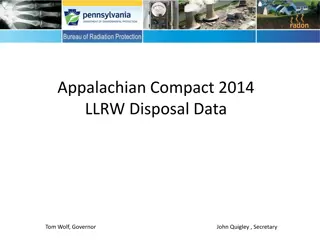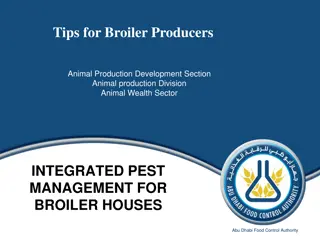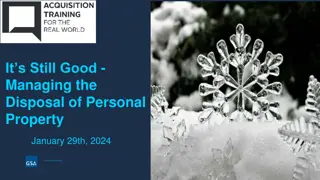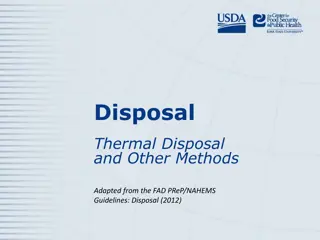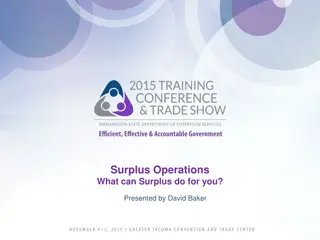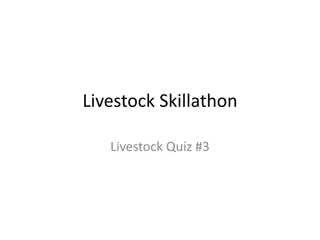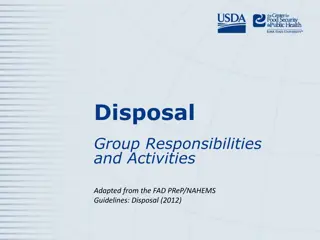Amino Acids: Disposal of Nitrogen
Overview of nitrogen metabolism with a focus on the disposal of nitrogen through amino acid catabolism. It explains the process of removing the α-amino groups from amino acids, the synthesis of urea, and the conversion of carbon skeletons to energy-producing pathways.
36 views • 65 slides
NARA’s Regulation for Digitizing Permanent Records
NARA has issued regulations and guidance for digitizing permanent records, including the disposal of original analog records, with the aim of enhancing efficiency and accessibility. The process includes reviewing and updating regulations periodically, transferring metadata when records are transferr
1 views • 20 slides
Urban Mining and CDW Circular Economy Cost-Benefit Analysis
This case study focuses on comparing the cost and greenhouse gas emissions savings of local processing and reuse of Construction and Demolition Waste (CDW) materials versus sending them to landfills. By developing a prototype cost and GHG savings calculator, the aim is to showcase the potential of e
0 views • 14 slides
Annual Disposal/Injection Well Monitoring Report Workshop Overview
Discover the key aspects of UIC Form UIC-10 and its instructions for reporting, monitoring, inspection, and compliance in the Injection and Mining Division. Learn about the annual submission requirements, community well information, and the Source Fluid Attachment process. Get insights into handling
0 views • 32 slides
Proposed Changes to Guam's Toilet Facilities and Sewer Disposal Act
Current controversies surrounding residential lot sizes, lack of flexibility in existing laws, and rising nitrate levels have prompted the introduction of Bill 175-37 (COR) in Guam. The bill aims to address shortcomings in existing regulations by allowing the development of 1/6 acre lots with Type 4
4 views • 10 slides
Challenges and Solutions in Urban Sanitation Infrastructure Planning
Sanitation plays a vital role in promoting public health by preventing human exposure to waste hazards and ensuring proper sewage disposal. This presentation covers key aspects of sanitation, including the generation, collection, treatment, and disposal of sewage in urban areas. It highlights the ga
0 views • 15 slides
Abattoir Practices and Bone Products Technology Overview
Bone constitutes a significant portion of the dressed carcass weight, with various types such as fresh green bone and desert bone. Bones are used in various industries for products like glue, gelatine, and fertilizer. Different methods of bone processing are employed to extract valuable components l
0 views • 42 slides
Overview of Carcass Evaluation and Grading in Livestock Processing
Carcass evaluation and grading are vital processes in the marketing and merchandizing of livestock carcasses. Dr. R. K. Jaiswal, a knowledgeable Asstt. Prof.-cum-Jr. Scientist, delves into the significance of evaluation, dressing percent, carcass length, back fat thickness, ribbing, loin eye area, a
1 views • 24 slides
Guidelines for Handling Case Properties and Seized Assets in Legal Proceedings
This informative content discusses the handling of case properties involved in offenses, including seizure, custody, disposal, and coordination among government departments. It covers various aspects such as the types of case properties, custody procedures, provisions under Section 516-A Cr.PC, and
0 views • 8 slides
Understanding Sludge Disposal Regulations in Oklahoma
Major facilities in Oklahoma must adhere to specific regulations when disposing of sludge, with two primary methods of disposal: Landfill and Land Applied. EDMRs must be submitted annually by February 19th, covering the previous year. Testing requirements include Toxicity Characteristic Leaching Pro
0 views • 30 slides
Ensuring Hygienic Disposal of Carcasses and Fallen Animals
Disposing of carcasses and fallen animals is a crucial responsibility for veterinarians to maintain environmental hygiene and prevent health risks. Improper disposal can lead to the spread of diseases and attract pests. Various methods, such as burial, cremation, and incineration, are used to ensure
0 views • 22 slides
Proper Handling and Disposal of Sharps - A Community Safety Concern
Improper disposal of sharps poses risks to public safety as it can lead to injuries from needles contaminated with blood-borne infections. This article emphasizes the importance of safe handling and disposal practices for sharps, including drug paraphernalia, to protect both individuals and the comm
0 views • 21 slides
Utilizing DOE Low-Level & Mixed Low-Level Waste Disposal Contracts
EMCBC manages disposal and treatment contracts for Low-Level Waste (LLW) & Mixed Low-Level Waste (MLLW). Eligible users include DOE offices, prime contractors, and subcontractors. Services cover various waste types including radioactive materials, sealed sources, and TSCA-regulated waste. Specific c
0 views • 19 slides
Proper Chemical Waste Disposal: Advice and Best Practices
Learn how to safely dispose of chemical wastes in compliance with local regulations. Follow expert advice on waste collection, avoid sewer and garbage disposal, and prioritize safety to minimize environmental harm. Training on responsible disposal practices is essential for creating a culture of sus
0 views • 18 slides
Effective Carcass Disposal Through Composting
Composting carcasses with organic materials can accelerate biological decomposition, destroy pathogens, and produce a nutrient-rich humus. Proper carbon-to-nitrogen ratios, moisture levels, oxygen maintenance, and temperature control are crucial for the efficiency of the composting process. Mixing a
0 views • 21 slides
Efficient Methods and Considerations for Solid Waste Disposal
Efficient methods for solid waste disposal include sanitary landfilling, which involves compacting waste and covering it with soil daily. Advantages of this method include economic viability and flexibility in waste disposal. However, challenges such as limited suitable land availability and potenti
0 views • 10 slides
Industrial Effluent Treatment in Fermentation Industries
Fermentation industries generate various types of effluent containing organic matter, solids, and other waste materials. With stricter regulations on waste disposal, efficient treatment methods are essential for controlled disposal. This includes physical, chemical, and biological processes to treat
0 views • 84 slides
Safe Disposal of Prescription Medications: Importance and Methods
Proper disposal of prescription medications is crucial to prevent harm to children, pets, and the environment. Safely dispose of unused medications to avoid accidental poisoning, misuse, and pollution of water sources. Methods include using authorized collectors, pharmacies, and take-back events, an
0 views • 5 slides
Guidelines for Animal Disposal Methods
Environmental and biosecurity guidelines recommend various disposal methods such as composting, rendering, permitted landfill, unlined burial, fixed-facility incineration, and open-air burning. Each method has specific selection criteria and considerations to minimize risks to the environment and bi
0 views • 17 slides
On-Site Burial for Carcass Disposal: Methods and Environmental Impacts
Explore the process of carcass disposal through on-site burial, covering topics such as trench burial, site selection, construction and design considerations, environmental impacts, and a comparison with other disposal methods. Learn about key factors influencing on-site burial, including soil prope
0 views • 13 slides
Beginner Farmer Meat Marketing Analysis & Strategies
Explore pricing strategies, market channels, and financial goals for beginner farmers in profitable meat marketing. Learn to identify desired profit, determine pricing per channel, and select viable sales avenues. Analyze market observations and plan sales projections for different meat types. Disco
0 views • 19 slides
Proper Waste Disposal in Healthcare Settings for Marburg Virus Disease
In healthcare settings, proper waste disposal is crucial during outbreaks like Marburg virus disease to prevent health risks for patients, staff, and the community. This involves incineration or non-burn treatment of infectious waste before disposal, emphasizing the importance of appropriate waste m
0 views • 16 slides
Regulations and Disposal of Pharmaceuticals Key Terms
Understanding the regulations around the disposal of pharmaceuticals is crucial to protect the environment and ensure safe practices. Unwanted pharmaceuticals should not be disposed of with regular trash or flushed as they can affect water resources. Incineration, governed by federal Clean Air Act r
0 views • 7 slides
Waste Disposal Regulations and Guidelines for Sanitation
Guidelines for waste disposal and sanitation laws under the Public Health Act are outlined, including definitions of nuisances, prohibitions, penalties, and training programs for sanitation teams. Failure to comply with regulations can result in fines. Proper waste handling and disposal are essentia
0 views • 8 slides
Proper Handling and Disposal of Hazardous Drugs and Waste
Guidelines for the safe handling and disposal of hazardous drugs and waste in healthcare facilities. The content covers training modules, waste collection, sources of healthcare waste, disposal methods, and legal regulations related to the disposal of hazardous drugs. Various types of healthcare was
0 views • 21 slides
Weirdest Foods from Around the World
Explore the bizarre world of unusual foods, from Khsh made of stewed cows feet and head, to Hkarl - the rotting shark carcass, Century Egg, Jing Leed grasshoppers, Witchetty Grub, and Mopane Worms. These unique dishes vary from being considered delicacies to being described as the worst tasting by s
0 views • 11 slides
Proper Disposal of Public Records Guidelines in Montana
Guidelines for proper management and disposal of public records in local government entities in Montana, outlined under HB 123 passed in 2015. The Local Government Records Committee (LGRC) oversees records retention schedules and reviews disposal requests. Contact LGRC for questions or assistance re
0 views • 24 slides
Football Field Complex Remedy Project Overview
The project involves remedial measures for the football field complex at Elmira High School, focusing on soil removal, groundwater monitoring, and vapor intrusion prevention. Excavation, disposal of hazardous waste, and construction of institutional controls are key components. Plans for interim rem
0 views • 15 slides
FLP Corrugated Waste Disposal Project Overview
This project aims to improve the efficiency and cost-effectiveness of the current corrugated waste disposal process. By implementing alternative designs and reengineering processes, the goal is to increase labor efficiency by 10%, reduce waste disposal costs by 10%, and provide recommendations for s
0 views • 8 slides
WIPP Waste Disposal Capacity Overview
The Waste Isolation Pilot Plant (WIPP) has a statutory capacity of up to 175,565 cubic meters for disposal of transuranic waste. As of June 2018, 93,500 cubic meters of TRU waste have been emplaced at WIPP. The facility operates within the 16 square mile land withdrawal boundary specified by the WIP
0 views • 8 slides
Applications of Transgenic Animals in Biotechnology and Cloning
Cloning in animals offers the advantage of indefinite duplication of elite genotypes without the genetic risks of meiosis. Transgenic animals, genetically modified to carry foreign genes, play a crucial role in genetic research and the development of livestock with desired traits. Methods like DNA m
0 views • 13 slides
Disposal Data of Appalachian Compact LLRW 2015
The data from the Appalachian Compact LLRW disposal activities in the year 2015 includes information on disposed volume and activity by state and facility type. Figures show cubic feet and curies disposed, detailing academic, government, industry, medical, and utility sectors. The disposal sites wer
0 views • 12 slides
Appalachian Compact 2014 LLRW Disposal Data Analysis
This data analysis showcases the disposed low-level radioactive waste (LLRW) volumes, activities, and trends as part of the Appalachian Compact in 2014. It provides insights into LLRW disposal by state, facility type, and activity levels, covering academic, government, industry, medical, and utility
0 views • 10 slides
Integrated Pest Management and the Use of Probiotics in Broiler Production
Tips for broiler producers include implementing integrated pest management strategies and utilizing probiotics in poultry feeds to enhance gut health, control diseases, and improve productivity. With concerns over antibacterial resistance, alternatives to antibiotics such as probiotics and prebiotic
0 views • 13 slides
Proper Management of Personal Property Disposal Process
Explore the steps involved in managing the disposal of personal property efficiently, including internal screening, excess screening, and utilizing resources like PPMS and NUOs. Learn about the various methods of disposal such as transfer, donation, and public auction. Discover how to identify if yo
0 views • 47 slides
Thermal Disposal Methods for Animal Carcasses: Guidelines and Best Practices
Explore thermal disposal methods adapted from the FAD PReP/NAHEMS Guidelines for effectively managing animal carcasses. Learn about high-temperature combustion, fixed-facility incineration, open-air burning risks, and air-curtain incineration techniques. These methods vary in efficiency, environment
0 views • 17 slides
Surplus Operations: How We Help Agencies Manage Property Efficiently
Surplus Operations, presented by David Baker, offers property management services to agencies including state and local governments, municipalities, school districts, and non-profits. Their mission is to recover, reuse, or recycle property to avoid disposal, saving money for agency partners. Service
0 views • 34 slides
Livestock Skillathon Quiz Questions
This Livestock Skillathon quiz includes questions about animal digestive systems, heritability, carcass composition, ear notching systems, mineral deficiencies, profitability factors in sheep flocks, protein content in cottonseed meal, products provided by hogs, and slaughter terminology. Test your
0 views • 12 slides
Guidelines for Disposal Group Responsibilities and Activities
Responsibilities and activities of the disposal group adapted from FAD PReP/NAHEMS guidelines include roles such as disposal method recommendations, organizing and directing activities, ensuring procedures are carried out, and performing disposal tasks. The group aims to mitigate pathogen spread, sa
0 views • 16 slides
Top Tips for a Smooth Garbage Disposal Installation in San Diego
Installing a garbage disposal can be a simple yet effective home improvement activity for your kitchen. With the disposal, you save your kitchen from trash while at the same time ensure proper clean-up after meals. Contact us now.\nFor more info - \n
0 views • 5 slides
